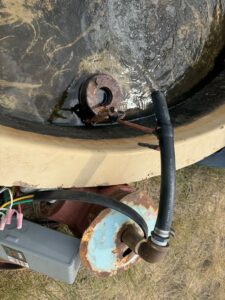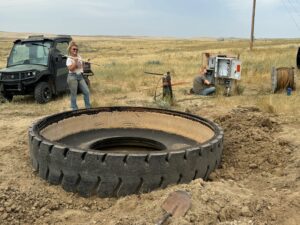Range Health
#bfrdpwy #aginternship #RightRisk
What a week. I don’t even know where to start because this was my last week at my host ranch. As I pulled away from the ranch, I felt a wave of emotions because this has been the best 10 weeks of my life. I am so grateful to this program, my hosts, and everyone that I have met along the way. I can confidently say I experienced real ranch life, and I love it. Every morning, I craved the mystery of the day and never knew what to expect. This week was a great reflection of this statement because I did a little of everything.

I started the week with weed management. This meant long hot days on a 4- wheeler. The pastures we sprayed ranged from 2,000 to 4,000 acres. This is a lot of territory to cover and made the days very interesting because every second was different. The weeds we sprayed for mainly grew in crick bottoms or in areas where moisture pooled. This made the terrain another challenge to navigate. For me, the rush of navigating the steep banks, bumps, and conclaves is very exciting. Past that, I don’t care much for spraying weeds. But not everything can be fun and enjoyable. Weed management is a must and is so vital for range health.
While spraying, I kept myself distracted by the wildlife, livestock, and native vegetation. I never cared what kind or grass or plant I found myself in, but while spraying I did. While navigating the pastures I kept an eye out for coyotes because just like weeds, they are a nuisance. I saw four while out and marked my location so the trapper could locate them. One morning I even was able to see the trappers plan out flying ridges. They were able to locate the predators and successfully remove them.

The rest of my week catered to the weather because the Wyoming wind was in full force. Wednesday was hot, dry, and windy. This is a perfect recipe for a fire. While Wyoming has many upsides, the fire season is not one of them. Many fires broke out around us, so we prepared for the worst. Our spray trailer quickly turned into a water hauling trailer. We filled many tanks and made sure the pump was operational. My host quizzed us on fire protocol and made sure we felt comfortable operating hoses. Looking back, this is such a great idea because that preparation is essential in a natural disaster. Honestly, I want to put together a whole book or go-bag for my own operation. This would help in case of an emergency and be the difference between life and death.
The final part of my week was mainly targeting the heat and problem shooting. The highs reached in the 100s, so we ensured the livestock were receiving enough water and staying healthy. We set up another tank in the yearling sheep pasture to help them utilize more pasture. The sheep congregated around the new tank and didn’t have to travel so far for water. The new tank is not a permanent fixture and only produced enough water to keep water in the tank. While not ideal, it still proved plenty of relief to the hot livestock.

Friday was mainly setting up a new tire tank in a pasture that only had one water source. This was a bigger task than I expected because there are many moving parts. First, we had to tap into the power from the power line. Then we had to convert that to a timer so the tank wouldn’t run 24-7. This wasn’t hard but was a meticulous process. Next, we leveled out where the tank needed to sit. Let me tell you, that ground was not easy to work with. I definitely gained some sweat equity with my shovel. After moving the tank and making sure it was level, we filled the middle with dirt and concrete. My host is an expert at setting these tanks because he has learned from the others on the ranch. This was awesome to reflect on and compare tanks so we could make this tank better than the last.
Submitted by: Maggie McStay
Edits by: GrowinG Internship Team

